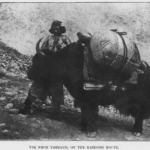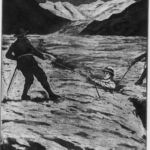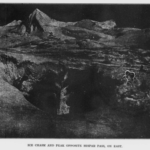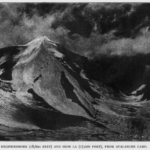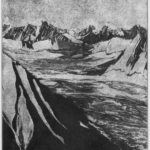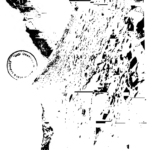Fanny Bullock Workman
A mountaineer, feminist, and outdoor enthusiast, Workman climbed to great heights in the Himalayas. She primarily traveled with her husband, though accomplished some mountaineering feats of her own as well.
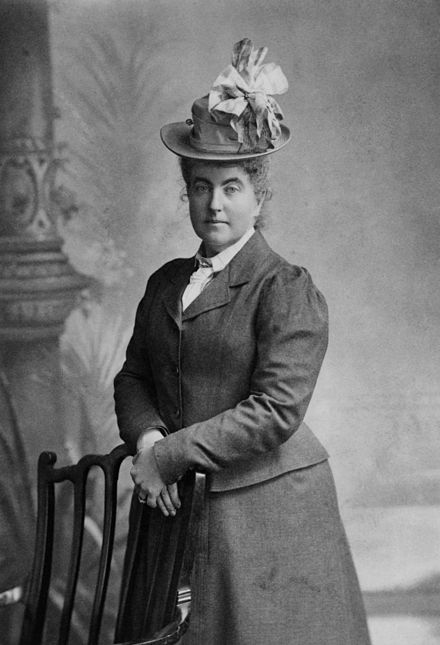
Themes
In 1908, Workman sent out a team of scientists to re-measure the altitude of Mount Huascarán after Annie Smith Peck claimed to have beaten Workman’s record of tallest peak ascended by a woman: “It was, of course, quite within the province of anyone to take so great an interest in the matter as to spend some thousands of dollars in sending engineers to Peru to make a triangulation of the mountain, and to public this as the absolute height of Huascarán.” In one set of letters they exchanged, which were published in the popular journal of the period, Scientific American, they publicly fought over who held the tallest ascent record. Peck defended herself, claiming that her measurement was an approximation and noted that she did not expect anyone to take it as an exact number. Peck pointed out how many expeditions she could have conducted with the thousands of dollars Workman commissioned the Huascarán team with.
“One difficulty is to get the men beyond the last inhabited huts where they always stop to eat, drink, and waste time, and another is to make them carry up wood and encamp on or near a glacier. They are always disinclined to stay overnight above wood and grass, and when one considers the light food they eat and their insufficient clothing one cannot wonder at it” (Mountaineering in the Himalayas, p. 449).
“I have stated the altitude of our highest camp as 21, 300 feet. This was measured by hypsometric readings compared with simultaneous ones at the lower Government station of Dras, 34 miles distant, where readings were taken for us three times daily during our absence. The same readings, calculated by Airy’s table, make its altitude 21,600 feet. The variation being so great, and airy’s table differing from others in placing sea-level at 31 inches and giving relatively higher altitudes for very low pressures, the results of calculations by it have not been used” (An exploration of the Nun Kun Mountain Group, p. 26).
“Mrs. Bullock Workman not only broke her last record-ascent for women of 22,568 feet, but won a place with Dr. Workman in the small band of mountaineers who have reached a height of over 23,000 feet” (An exploration of the Nun Kun Mountain Group and its Glaciers, p. 29).
“It was, of course, quite within the province of anyone to take so great an interest in the matter as to spend some thousands of dollars in sending engineers to Peru to make a triangulation of the mountain, and to public this as the absolute height of Huascarán” (Women of the Four Winds, p. 59).
Workman uses the word “coolies,” which often refers to migrant, indentured laborers in Southeast Asia. Her writings demonstrate the lack of respect and agency she assigned to those who helped her accomplish her explorations of extremely technical glaciers that she would not have been able to navigate without the help of many people.
“When we had seen all that we cared to of the great glacier we secured a new set of men from the chiefs of Askole, a village in the valley of that name, and started for some climbing in a mountain chain between the Askole and Shigar valleys. Having chosen one’s mountain, the next proceeding is to bring the coolies and camp successfully through the ascending valleys, across the unbridged, often-tumultuous mountain torrents and over the tiresome slipper moraines“ (Mountaineering in the Himalayas, p. 448).
“[The natives] threw down their loads and put up their hands in an attitude of prayer which with these natives means, ‘Please go back to the warm valleys’…I called the interpreter and told him to tell the men that if they would not go on we should stay there until we had finished what we wished to do, if it took a week” (Mountaineering in the Himalayas, p. 449).
“I have named this northeast glacier the Team Shehr, which is almost the only native name connected with the Siachen of which the oldest inhabitants have a dim remembrance. A flour base camp with a babu in charge was made on moraine a little farther up the glacier” (Survey of the Siachen Glacier, p. 899).
“Here fog and snowstorms self us prisoners for nine days. At the beginning of this detention I ordered forty coolies to return under two Europeans over the Bilafond glacier for Floyd, which was now running short. This brought on a strike which laster eighteen hours. They refused to go for a strike which lasted eighteen hours. They refused to go for supplies, saying, if they went, they would not return. Their long visit to the sources had made a deep impression on their minds and they declared they would not return there. Finally, upon the Wazir explaining that, if they crossed the new pass, they would have only two days on snow and then be always on moraine down to villages, they gave in and no further complaint was heart. Flour arrived, and one bitterly cold morning, under a leaden sky, we started with 66 coolies laden with provisions for ten days” (Survey of the Siachen Glacier, p. 901).
Although Workman’s mountaineering accomplishments are significant to say the least, her wealth granted her a more catered experience; she had the option to be carried down the mountain if she wanted, and she did not bear the weight of her own gear when climbing.
“Although at about the height of the Matterhorn, this was on a convenient grassy ledge with water running at ten minutes’ walk form the tents, and lucky we were to have so good a place, for thunder, hail, and snowstorms kept us stationed there for three days. When it cleared and we wished to take the men up a thousand or two more feet over rocky walls and jagged arêtes to find a higher camp they refused to go. After much parleying this obstacle was overcome by reducing our camp kit to the lowest limit and by offering a few of the better coolies substantial bakshish” (Mountaineering in the Himalayas, p. 450).
“The wind blew down upon us in strong gusts the whole night, shaking the tents so that we feared we should be carried down into the bergschrund. This, with the altitude, the effect of which all felt decidedly, effectually prevented sleep” (An exploration of the Nun Kun Mountain Group, p. 23).
Workman did many things on her travels, one of the most significant activities was mapping the places she visited. It is important to consider how maps from the 19th century were not objective truth but rather informed by the identity factors of the geographer: social status, race, company, etc.
“The object of the 1912 expedition was was to make as detailed a map as possible of the whole glacier and to ascend to and examine its apparently somewhat complex sources, and elucidate, if possible, the problem of their relations to regions beyond” (Survey of the Siachen Glacier, p. 897).
“We did [suffer from cold], however, and when we reached the windy, icy goal could hardly endure the cold in hands and feet long enough to take the necessary observations” (Mountaineering in the Himalayas, p. 452).
“The gala is enclosed on both sides by precipitous mountain-walls. For some distance above its mouth its bed consists of rolling hillocks, sparsely covered with vegetation. A large colony of marmots had appropriated these as a site for a subterranean city, and their burrows pierced the ground at short intervals in all directions. These marmots were evidently social in their habits, and exchanged frequent visits, as was shown y footpaths as distinct and well trodden as those made by men, running between the different burrows and forming a network over the whole surface” (An exploration of the Nun Kun Mountain Group, p. 14).
“The afternoon was windless and oppressively hot. The sun shone through drifting mist with a sickly light, but with a heat that seethe mercury in the solar thermometer up to 193 Fahr. at 2 o’clock, and to 142 Fahr. at 3.30 o’clock” (An exploration of the Nun Kun Mountain Group, p. 25).
“One of my Italian porters, through momentary carelessness in not testing the ice with his axe, fell into a deep crevasse, carrying with him the only rope with us at the time. He remained there one and a half hours before ropes and guides were available to extricate him, and died of shock and the effects of cold the same night” (Survey of the Siachen Glacier, p. 902).
"We did not fancy the prospect of being left in such a place, at such an altitude, cut off entirely from all communication with the outer world, in weather which appeared to be uncertain, and in a temperature which, though now too warm for comfort, was sure to fall to or below zero before morning, but this contingency had to be faced" (Peaks and Glaciers of Nun Kun, p. 74).
Image: W. L. Walton, Kinchinjunga from Mr. Hodgson’s Bungalow, 1854.
Places Visited
Workman and her husband completed many cycling tours together: Workman, Fanny Bullock, and William Hunter Workman. Sketches Awheel in Modern Iberia. GP Putnam’s sons, 1897.
“[The Workman’s decided to employ an Englishman as valet cum cycling luggage carrier, and much of Fanny’s account of their six-week cycling tour deals with the shortcomings of this unfortunate individual. After a series of spectacular accidents, no doubt precipitated by the effect on his stability of the mass of luggage he was expected to carry on his handlebars, he finally cycled over a precipice in a rainstorm” (The Workmans: Traveller Extraordinary 233).
In the Nun Kun region, they hired several Italian guides, in addition to their German guide because they did not trust the local people. While here, they focused on some geography goals, trying to map the region from observations and use of a compass.
“On 17th July we left Moraine Camp with our whole caravan, and marched up the glacier to join the guide and porters at Base Camp. For more than a mile we followed the steep, torn, and boulder-covered left or west bank, and then descended to the glacier, where for another mile we picked our tortuous way over, up and down, in and out of, its rock-smothered ravines, hillocks, and ridges, to the smooth white ice, over which we passed without difficulty, till the crevassed red section adjoining the mountain-side had to be crossed, where care was necessary” (Peaks and Glaciers of Nun Kun, p. 48).
“The icy slopes leading up were very sharp and approachable only by step cutting. I recall feeling giddy and ill on these cold slants; in fact, had the first attack of mountain sickness I had experienced on the glacier. When we reached the ledge under the cliffs we were at 16,450 feet, 650 feet higher than Mt. Blanc. It was a most glorious point of view, and while we waited for the tents to be spread on the icy surface of the terrace, although shivering and longing for hot tea, we rejoiced in our lonely but grand bivouac, which for no price would we have exchanged for the warmer, more noisy Swiss hut” (Mountaineering in the Himalayas, p. 448).
“From this plateau the Nun Kun peaks did not appear so impressive as their altitude would lead one to suppose, or as those that can be seen appear from the region outside” (Peaks and Glaciers of Nun Kun, p. 73).
Both Fanny and her husband were incredibly fit by physical standards. They cycled and mountaineered at a level of physical endurance that would be regarded as unique, particularly considering their ages, which reached the 50s and 60s during the peak of their expeditions. When the Workman’s are written about, their tenacity and drive is often remarked as being exceptionally high. However, this confidence they had in their scientific and technical abilities also colored their perspectives with a significant sense of entitlement and a cockiness of sorts.
“Their first Himalayan journey [in Srinagar] would be considered a formidable undertaking, even today, by modern trekking companies. The 250-mile trip from Srinagar over the Zoji La to Let, made of course long before this became a jeep road, they regarded as so commonplace as not to be worthy of description. At Let, they immediately set to work to organise a journey along the southern branch of the Silk Road to the Karakoram Pass (now closed for political reasons), an even more formidable undertaking” (The Workmans: Traveller Extraordinary, 233).
“Late in the summer of 1898, in descending the Rangdum valley on our return from Northern Ladakh and the frontier of Chinese Turkestan, we saw for the first time these mountains towering above its western end. Several dazzling white snow and rock-peaks lifted their heads high above the neighbouring mountains, surrounded by a multitude of sheer rock-aiguilles with tops dashed with snow, which, tinged by the red afterglow at evening, shot up into the cold grey sky like prongs of flame” (Peaks and Glaciers of Nun Kun, p. 1).
“On the the first attempt lasting two or three days we camped far up the glacier at 18,000 feet, but were driven down in a stinging snowstorm early the next day” (Survey of the Siachen Glacier, p. 900).
The way Workman referenced the “coolies” working for her and the way they would not feed the birds with their own food, of which they had little as it was, is a striking critique in its absurdity, not to mention hypocritical, as Workman’s own comfort was a heavily recurring topic of writing.
“We surmised that the propinquity of the 14,000 foot glacial Boot Kol pass might have had a good deal to do with their departure, as the Islamabad coolies are notorious cowards when required to venture on snow, and our surmise proved to be correct. The resident was consulted as to what could be done, and asked whether the native authorities would not compel the coolies to return and fulfill their contract, which they had voluntarily entered into at wages one-half greater than those usually paid, or furnish others in their place” (Peaks and Glaciers of Nun Run, p. 6).
“These fowls were carried on the march by the coolies, being distributed among them for this purpose. Journeying in this manner is no sinecure for the fowl. Its legs are tied together with a swollen thread, and it is perched on the top of the coolie’s pack, to which it is secured by the free and of the thread” (Peaks and Glaciers of Nun Run, p. 19).
“They devote to their own use all the grain they can obtain either honestly or by theft, and would see fowls starve to death under their eyes rather than give them the minutest portion” (Peaks and Glaciers of Nun Run, p. 20).
“The question which we could not solve with certainty was that of the descent, as the rocks and ice-walls fell away so steeply that they were not visible for any great distance from where we stood” (Peaks and Glaciers of Nun Kun, p. 111).
"The next day's march was not long, bit it was trying to the nerves. We had first to scale the ice-wall above the camp, and then ascend over a long, snow-covered ice-slant with a convex surface inclining from 50 degree to 60 degree at different points, separated from an ice-wall beneath by a wide bergschrund, which ran along its whole base" (Peaks and Glaciers of Nun Kun, p. 64).
Image at https://discovery.cathaypacific.com/pushing-boundaries-mountaineer-fanny-bullock-workman/.
